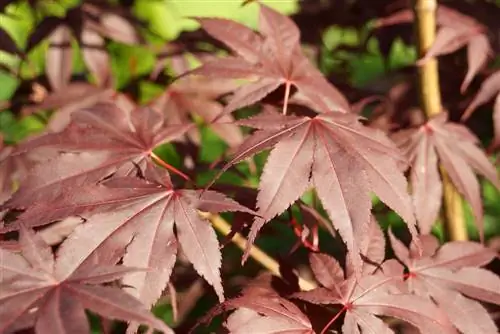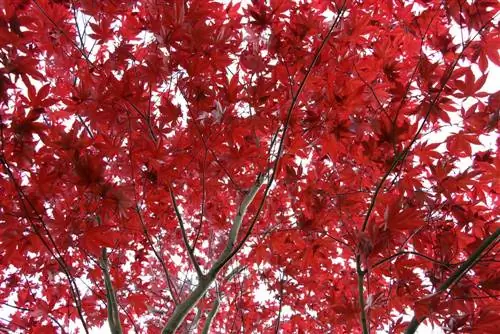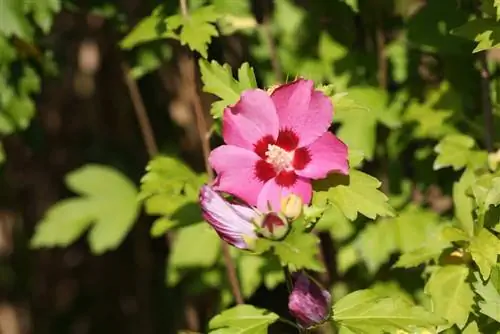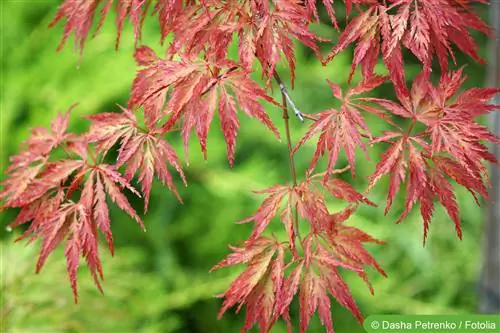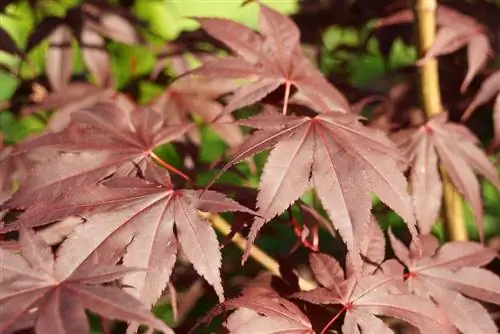- Author admin [email protected].
- Public 2023-12-17 03:39.
- Last modified 2025-01-24 12:45.
Color and shape make the red Japanese maple a decorative addition to the garden - and a striking exotic that can be found especially in Asian-inspired areas. In order for it to retain its beauty, you don't even have to put in a lot of effort. However, the unusual tree is picky in at least some respects. However, if its basic requirements are met, it is also suitable for beginners in garden care. Anyone interested can find out what’s important when it comes to culture and blends here.
Location
In a sunny location, not only does the color of the red Japanese maple stand out particularly well, the tree is also doing exceptionally well here. The plant wants plenty of warmth and light, but it doesn't tolerate wind very well, especially at the beginning. A planting location protected from heavy rain and cold drafts, for example towards the south and near a wall, is therefore ideal. When choosing a suitable location, it should be noted that the Japanese maple can grow up to 7.5 meters high and correspondingly expansive. So there shouldn't be a lack of space and upward space.
Substrate
Neutral pH or slightly acidic - the main thing is that the substrate is permeable to water and humus. The loose nature is particularly important, as the red Japanese maple tolerates compaction and waterlogging in the soil extremely poorly. In fact, this is the most common reason for the tree to end prematurely. If such soil is not already available, sand and coconut fibers should be mixed in to loosen it up. Mature compost as a nutrient enrichment is also a useful addition.
Tip:
The substrate is best suited for the red Japanese maple if it has a light, crumbly structure - i.e. it falls apart in the hand and trickles down easily.
Pouring
As already mentioned, the red Japanese maple cannot tolerate waterlogging - but it still needs plenty of moisture. Since the attractive tree is a shallow-rooted tree, it cannot take care of itself particularly well, especially in summer. It may be necessary to water in the morning and evening, especially during dry phases and for young plants. Watering is also carried out in winter so that the substrate never dries out completely. But then only on frost-free days. Because the tree prefers a neutral or slightly acidic environment, you should use soft, low-lime water. Rain or stale tap water is ideal.
Tip:
A layer of mulch or gravel on the tree disc reduces evaporation and thus the necessary frequency of watering.
Fertilize
If some compost was initially added to the substrate, additional nutrients can be dispensed with in the first year of growth. The red Japanese maple is then only fertilized again in the second year. Compost is well suited for this, but also special maple fertilizer in liquid form. It is sufficient to work the compost lightly and superficially into the soil once in April and once in June. Particular caution is advised here as the roots run shallowly in the soil. If liquid fertilizer is used, it can be added to the irrigation water or used in diluted form to spray the crop. In this variant, fertilization takes place every two to four weeks from April to August.
Cutting
When cutting the red Japanese maple, you should proceed with extreme care and caution. As a rule, the tree cannot tolerate radical shaping and even when it comes to corrections, restraint is the magic word. The reason for this is, on the one hand, that the cut surfaces continue to bleed for a long time. Cutting into living wood weakens the tree considerably. On the other hand, the maple generally tends to let cut branches die off completely. If you want a more malleable plant in the garden but don't want to do without the maple, you should choose a variety that tolerates cutting - such as cultivated forms of the field maple. When cutting the red Japanese maple, however, the following points should be taken into account:
- only remove branches that are damaged, snapped or dried by frost
- If possible, do not cut into living wood
- choose late summer or autumn as the time, then the wounds won't bleed for too long
- When cutting larger branches, if necessary due to bleeding, close the wounds with tree wax
- Disinfect saws and scissors before use to avoid infections
After cutting, carry out regular checks for pests and diseases, as this makes the red Japanese maple more susceptible.
Nevertheless, small corrections, and only if they are absolutely necessary due to damage, are better than shaping or major interventions. This is due to the fact that the natural shape is a special enrichment.
Wintering
The red Japanese maple is hardy in a suitable location as long as it has had enough time to grow before the frost. The only winter care it needs is occasional watering so that the substrate never dries out completely. To avoid damage, watering should only be done on frost-free days. In very cold winters, strong winds or late frosts, light protection made from garden fleece is recommended. Dark foil can also be used, as the maple loses its leaves anyway.
Wintering in a bucket requires a little more effort. The maple tree should initially be placed as protected as possible in the plant container. A wall or near a house wall is again favorable. The bucket should also be placed on Styrofoam and wrapped with garden fleece. Blankets and straw mats are also suitable for this. The red Japanese maple can also overwinter indoors if it is cool here. It doesn't need light during this phase, but it does need water. Since the tree in the container is even less able to take care of itself and no precipitation reaches the earth, watering should be carried out regularly in small quantities.
Propagate
The red Japanese maple is propagated via grafting or cuttings. While grafting requires some experience and sensitivity, the chances of success with cuttings are not that high. Propagation is not necessarily recommended for beginners.
Typical diseases, pests and care errors
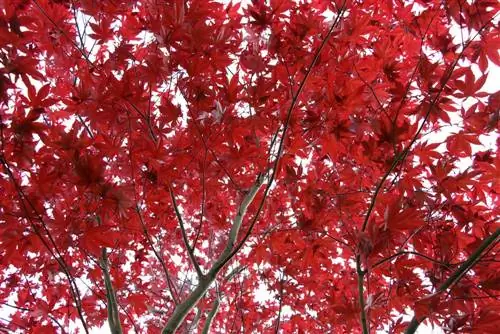
Mildew and verticillium wilt can affect the red Japanese maple, and it is particularly susceptible to this after cutting. However, an optimally chosen location with plenty of sun and little cold wind as well as the right one strengthens the plant and can reduce the risk of diseases and pests. Regular checks and immediate intervention are also essential, especially with younger plants, in order to be able to save the plant.
Conclusion
If a few factors are taken into account, the red Japanese maple is an easy-care and particularly beautiful tree - which can even do without cutting. As long as the location, irrigation and substrate are right, it delights like no other plant with the color of its leaves and the natural growth habit.
What you should know about the red Japanese maple
Location
- The red Japanese maple likes a sunny to partially shaded location that should be protected from the wind.
- Wind can affect the growth of the tree and often leads to leaf tip drought.
- An incorrect location promotes spider mite infestation.
Planting substrate
- The red Japanese maple prefers loose, humus-rich soils. Drainage in the soil or in the pot is important.
- The tree can also be cultivated in a planter. The soil may be slightly acidic.
- The ideal pH value is between 4.5 and 7.0.
- The tree feels most comfortable in sandy loam soil, but can also cope with other substrates.
- Waterlogging must be avoided at all costs, as this causes the roots to die.
- If you keep the red Japanese maple in a pot, you have to make sure that the container is large enough.
- Repotting takes place about every five years.
Watering and fertilizing
- The red Japanese maple is quite frugal.
- When it is dry, it needs to be watered sufficiently.
- Waterlogging must be avoided at all costs.
- You should be careful with nutritional supplements.
- Giving mineral slow-release fertilizer in spring is a good idea.
Cutting
Maple generally does not tolerate cutting well. The wounds bleed and pathogens tend to penetrate. In addition, the tree does not sprout new growth from old wood. Branches that have been completely removed from the trunk are almost impossible to replace. It is best to let the red maple grow as it naturally wants. This looks best on these trees. Interfaces are always visible and disrupt the appearance. If you have to cut, you should always leave some young wood with sleeping eyes so that new growth can occur. But you shouldn't cut too close either, as the maple always dries back a little. Sleeping eyes can also be affected.
Wintering
- The red maple is sufficiently hardy if it has a protected location.
- The planting substrate must not be too wet, otherwise the shoot tips may die.
- Especially when growing in planters, care must be taken to ensure that the water can drain off easily and that the tree is not too wet.
- However, you should not forget that the tree also needs water in winter, of course only on frost-free days.
- Winter protection is recommended when planting in containers. The tree should not be exposed to temperatures significantly below -10 °C.
Propagation
Propagation occurs by seeds or by grafting. But this is mostly done in tree nurseries
Diseases and pests
- Spider mites are often seen as pests. They settle primarily on weakened specimens and must be combated. Aphids also appear in July and August.
- In addition, many maple trees suffer from verticillium wilt. This is a fungal disease that invades the plant from the soil. The fungus is often introduced into new plantings. You can recognize the infestation by the wilted leaves. Newly sprouted shoots suddenly show wilted leaves. The leaves are limp and have an unhe althy pale green color. Branches are also affected. The fungus clogs the water pipes. You can't fight him directly.
Prevention is best
This includes maintaining the culture conditions as optimally as possible. Plant tonics can also be used. Lowering the pH value can reduce the risk of infection. The permanent bodies can be killed by professional composting. Usually the only option is to cut affected branches and shoots back to the he althy wood.

